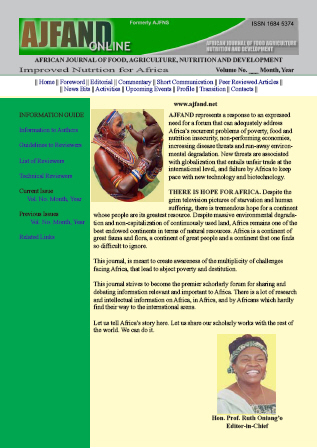
|
African Journal of Food, Agriculture, Nutrition and Development
Rural Outreach Program
ISSN: 1684-5358
EISSN: 1684-5358
Vol. 13, No. 1, 2013, pp. 7213-7224
|
 Bioline Code: nd13009
Bioline Code: nd13009
Full paper language: English
Document type: Research Article
Document available free of charge
|
|
|
African Journal of Food, Agriculture, Nutrition and Development, Vol. 13, No. 1, 2013, pp. 7213-7224
| en |
SIMPLE EVAPORATIVE COOLING METHOD REDUCES BACTERIAL CONTENT OF TRADITIONALLY MARKETED CAMEL MILK IN ISIOLO COUNTY, KENYA
Adongo, A.O.; Coppock, D.L. & Wayua, F.O.
Abstract
Milk marketing is important for many pastoralists to generate income, especially poor
households residing near towns. Milk is typically collected in plastic containers using
unhygienic methods at pastoral settlements. It is then transported—often over long
distances—to market on foot, by pack animals, or automobiles. Despite the challenges
of ambient heat and lengthy transportation periods, pastoralists or traders do not
attempt to cool marketed milk and thus reduce the risk of spoilage. Spoilage of
marketed milk is an important problem that limits urban demand and endangers
human health. There is a need to find simple and cost-effective means in such
situations to improve milk quality and benefit producers and consumers. The study
objective was to determine the effects of using water-soaked hemp (burlap)—wrapped
around 3.0 litres plastic containers—on reducing the temperature and enhancing
chemical qualities of marketed camel milk, a key commodity in Africa’s dry lands.
The work was undertaken in north-central Kenya in a milk catchment incorporating
pastoral settlements at Kulamawe and the market destination of Isiolo town. An
experimental design that mimicked the daily milk collection and transport procedures
was used. Pairs of plastic containers—with or without moistened hemp—were carried
first by donkeys and then by lorry on eight market runs during the dry season.
Samples of milk were taken at the early morning milking at Kulamawe and again after
arrival at the Isiolo market in the late afternoon. Milk was analyzed for temperature,
resazurin reactivity at 10 and 60 minutes (i.e., R10 and R60), and total bacterial count
(TBC). Effects of milk container placement during transport, treatment, and time on
milk attributes were assessed using an analysis of variance for a randomized complete
block design, with blocks based on eight instances of milk being transported to
market. A factorial treatment structure also incorporated time as a repeated measure.
On average, milk took 7.4 hr to cover 80 km to market. Compared to the controls,
upon arrival at market, the moistened hemp treatment significantly reduced (p ≤
0.028) milk temperature by 10% and total bacterial count by 43%. It also significantly
increased (p ≤ 0.023) R10 and R60 milk-quality values. This simple and readily
adoptable intervention can therefore reduce risks of milk spoilage along such a value
chain under similar field conditions.
Keywords
Appropriate Technology, Value Chains, Pastoralism
|
| |
© Copyright 2013 - African Journal of Food, Agriculture, Nutrition and Development
Alternative site location: http://www.ajfand.net/
|
|
